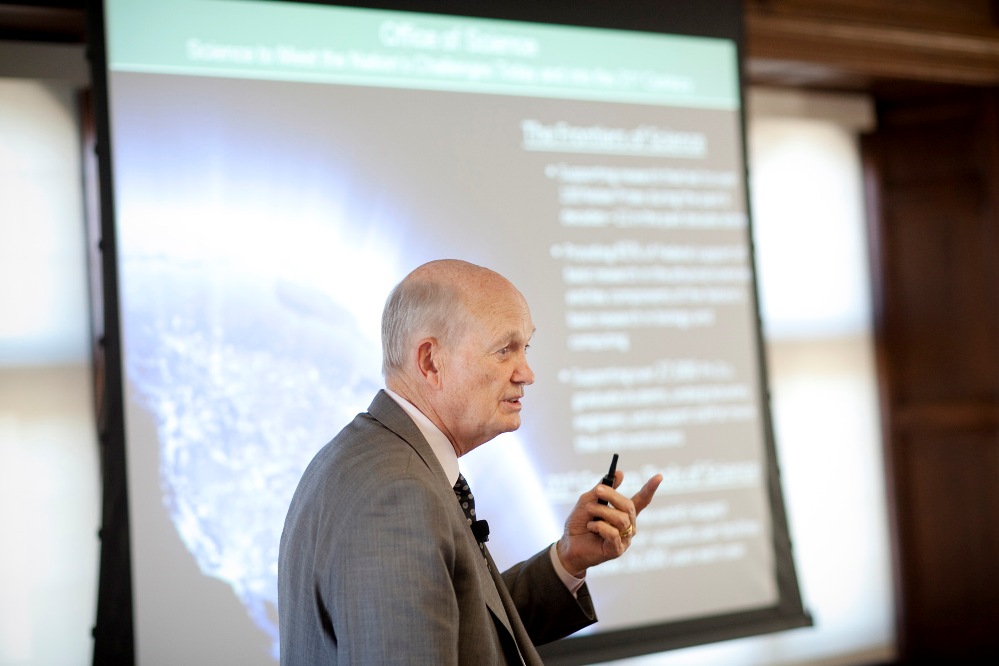Federal official calls for mobilization around energy issues
William F. Brinkman, director of the U.S. Department of Energy office that is the nation’s single largest funding supporter of basic research in the physical sciences, made the case for the crucial role science must play in the drive to clean energy during a Lehigh visit.
As head of the DOE’s Office of Science, Brinkman oversees a budget that includes $4.7 billion in appropriations, plus an additional $1.6 billion from the American Recovery and Reinvestment Act. The office provides more than 40 percent of total funding for research in the physical sciences, and is the principal federal funding agency for research programs in high-energy physics, nuclear physics and fusion energy sciences.
Addressing an audience that included members of the university’s board of trustees, administration, faculty, staff and students at Linderman Library Thursday, Brinkman outlined the scientific evidence that rising carbon dioxide (CO2) levels in the atmosphere contribute to rising surface temperatures globally.
He cited data gathered by the Gravity Recovery and Climate Experiment (GRACE) satellite, which show that the rate of ice mass loss in Greenland has more than doubled, from 137 gigatons (GT) per year in 2002-03 to 286 GT per year in 2007-09. Similar results have been found in Antarctica, which has seen the rate of ice mass loss increase from 104 GT per year from 2002-06 to 246 GT per year from 2006-09.
He also summarized evidence that CO2 levels in the atmosphere have increased substantially, from below 280 parts per million (ppm) before 1800 to 388 ppm currently.
Funding across the spectrum
After reviewing the evidence, Brinkman said: “At least one thing you can say is that the CO2 in the atmosphere surely has come from fossil fuels.”
To prevent the global surface temperature from rising more than 2.5 degrees Celsius (or about 4 degrees Farenheit) by 2050, Brinkman said it is imperative that total emissions of CO2 not exceed 1,000 GT between 2000 and 2050. However, from 2000 to 2010, we averaged CO2 emissions rates of 33 GT per year—meaning we must reduce our emissions by a factor of 8 over the next four decades, he said.
“That’s a huge, huge challenge,” Brinkman said.
That’s why the Office of Science is funding research across the energy spectrum, from carbon capture and sequestration to solar energy, and from biofuels to nuclear power.
“We’ve got to attack the whole picture,” he said.
His office is supporting research to develop new technologies and new materials, all with an eye toward increasing efficiency while lowering costs. Over the past three decades, for example, the cost competitiveness of solar power has increased dramatically.
But it still costs an average of $4/watt, which makes it too expensive, he said. If the cost to produce solar energy can be lowered to around $1/watt, it will be competitive enough cost-wise to play a larger role in our nation’s energy needs, he said.
Brinkman was senior research physicist at Princeton University before he was named to the DOE post in 2009. He previously was vice president of research for both Bell Laboratories and the DOE’s Sandia National Laboratories.
Brinkman concluded his presentation by showing the old Army recruiting poster depicting Uncle Sam pointing his finger at the viewer, with the slogan: “I Want You!”
“I think energy issues are the leading issues of our era,” he said. “We’re going to have to mobilize the country in a way that’s similar to the way we mobilized around Sputnik and the way we mobilized around World War II.”
Posted on:


